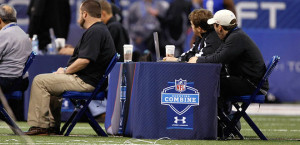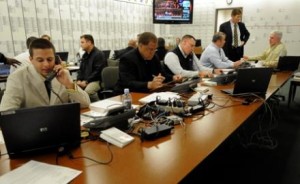Welcome back. This is the final installment of my 7-part series detailing the NFL Draft from a team perspective and the years of preparatory work that goes on behind the scenes. I encourage you to read the whole series, because each part offers unique exclusive content that is essential to the process!
Part I – Part II – Part III – Part IV – Part V – Part VI
 Some Fallacy
Some Fallacy
As humans, we sometimes will not do what is best for us. This same tendency applies to the NFL Draft. Team staffs have put forth a ton of energy to acquire as much information as possible and rank players accordingly, so it makes perfect sense to always select the best player available at the time of the team’s selection choice. This best player is determined by simply looking at the board to see which player available has the best grade. However, sometimes teams are affected by a positional need. Teams may “reach” for a player at a position at which they believe their roster needs immediate help. Teams may see a run on a certain position and select a player at that position before the players of value have all been taken. Another case might be that the best available players on a team’s board may be at a position in which they believe their roster already is strong, or the team may already have selected one or more players at that position in the Draft: Selecting any more players at that position will likely result in having to trim extra players at that position at the end of training camp.
One of the worst mistakes teams can make is letting emotion take over during the Draft. It is not hard for this to happen, because the Draft is just like a high-stakes game of speed chess. Making the right pick with internal pressures can present a stressful situation. Sometimes a coach or another executive will really get emotional and push last minute for a certain player he wants, and if the General Manager does not keep a level head, he can be influenced or persuaded. A good General Manager knows that he needs to stick to his board, because he spent months building it in its’ current state and ranking order. These coaches and/or executives can be difficult to ignore if they really like a player or become desperate if the Draft hasn’t gone as they would have liked.
 Value or Need?
Value or Need?
Leading up to the Draft, you will hear teams state that they will be wise and “stick to their boards.” Now you know that means that they intend to stick to the rankings of their Draft board and select the highest graded player available. The challenge is actually following through! Teams cannot let an internal pressure or a positional need override the years of work that their boards reflect. After the Draft you will hear about which teams selected for need or value, but only the teams themselves know if they actually selected for the best value on their boards or if a positional need took precedent.
As I touched on in Part IV of this series, something unexpected always happens. Does the team wait to draft a particular player betting that no other team has him graded as high? After all, it doesn’t make sense to use a 4th round pick on a player if he will be there in the 5th round. But will he still be there, or does another team covet him as much? What if the board is ‘wiped off’ early at a certain position? What if a player with a high grade but one big blemish has fallen to the team when the team’s grade indicated he should have been selected over 50 picks ago? What if trade talks have fallen through or didn’t present any gain in value? This is all part of the strategy.
 The Mad Dash
The Mad Dash
Only 256 players are actually drafted, so hundreds of players have a legitimate reason to be disappointed once the Draft ends. Many of these players are good enough to make an NFL roster. At the very least they offer quality competition in training camps, and teams know that.
Consequently, just because the Draft has ended does not mean a team is done for the weekend. No, these undrafted players are still available. Teams are targeting some of them, and teams have even strategized for such a scenario knowing that certain players would not be drafted by other teams. They may have chosen to instead use their 7th round Draft picks on players that would have otherwise been selected by another team before the Draft concluded.
So how does a team guarantee that it acquires players it wants after the Draft has ended? Well, it is similar to finding a prom date, because the player needs to decide if he wants to accept the first offer, the best situation, the biggest bonus, or the best suitor. Or maybe he gives complete control and trust to his agent. Maybe he makes a family decision. Regardless of the motivating factors, this process occurs in the hours immediately following the Draft! If an available player waits until the following day to decide, he will find himself with a smaller amount of offers and probably none at all. Teams fill their positional needs immediately: To wait would subject them to the possibility of missing out on the best remaining talent after the Draft. Simply put, teams will not wait on these players.
 Sudden Interest
Sudden Interest
As the last round of the NFL Draft is coming to a close, different members of the team staff will be responsible for calling players still available to encourage them to sign with their team immediately after the Draft, if they are not selected. These responsibilities are assigned to all scouts and coaches prior to the Draft so that when the Draft ends the phone calls offering contracts can immediately commence! For example, each scout will likely call players targeted in his region and each coach will call players targeted within his position group. Each team will add players to fill up its remaining roster spots, and this usually amounts to about 12 to 20 players.
Teams must determine their positional needs after the Draft to determine which positions to target and which undrafted players are most valuable to them. Signing bonuses ranging from $500 to $30,000 per player are then assigned accordingly. These signing bonuses generally stay small, as these players are not anticipated to make the final roster, but they are worth a gamble.
Instead of taking a break after 3 days of stressful high-energy drafting, teams instead conclude with this ‘high speed phone dance!’ But in the end, although they may be tired, teams always leave the Draft feeling optimistically excited about the youth added to the roster and their potential for success!All 32 teams are making phone calls to the agents of undrafted players and the players themselves, so these players need to determine which calls to answer and how long to stay on the line. Do they accept the first offer or wait for another offer to possibly come? What if they wait too long, and the first offer disappears? What if the best offer doesn’t offer the player the best roster situation? Is it worth holding out for a bigger signing bonus? The smartest agents usually advise their clients to take the first offer that presents a desirable roster situation. Holding out for more money or more offers will not help the long-term success of the player. As quickly as they agree to sign, the contracts are faxed out right away to these players.

Were We Right?
Even though there is all kinds of instant analysis after the NFL Draft has concluded, it will actually take years to determine which players actually were great Draft choices. Teams have years of development to apply, and these players might wash out in the meantime due to injury, not fitting the pro system, or simply being unable to perform at the speed and under the pressure at the NFL level.
Rather than reading the instant analyses and opinions after the Draft, I like to go back and review the Draft classes from 3 years ago. That is when one can determine the REAL winners. Looking at a player’s success after about 3 years will result in the most accurate assessment. Sometimes it is as simple as looking at if these players are still on the roster.
The best team executives understand this measurement of success and reward their staff accordingly. They know there needs to be a system of accountability, because without one, scouts and coaches will simply become a group of “yes men” who may or may not put the extra effort into truly getting to know the details about a player. Maybe a scout’s grades never goes outside of a medium comfort range relative to industry opinion when grading, because he has no incentive to stand on the table for players. Maybe a coach grades too many players too high, because he wants new and potentially better players at a position. Simply put, a good General Manager should recognize that if a scout or coach grades enough players incorrectly, he should be let go.
After all, the NFL Draft is more than an event. It is the lifeblood of an organization. It is a team’s future success or failure. It is a complete team effort that will make the difference between winning and losing. In his wisdom, one of my fellow superiors would often state: “It’s not about who is right, but it’s about getting it right.” For the sake of team success, it is vital to get it right.
I hope you enjoyed this series. Check back next Friday for a new article on sports business. If you have any ideas for future articles, I can be contacted directly. Comment below and send us a tweet and follow @SportsNetworker



Hey There. I found your blog using msn. This is a very well written article.
I will make sure to bookmark it and return to read more of your useful info.
Thanks for the post. I will certainly return.
Hi there just wanted to give you a quick heads up and let you
know a few of the images aren’t loading correctly.
I’m not sure why but I think its a linking issue.
I’ve tried it in two different browsers and both show the same results.
Attractive element of content. I just stumbled upon your
website and in accession capital to assert that I acquire in fact enjoyed account your blog posts.
Anyway I will be subscribing to your augment and even I achievement you get
admission to consistently rapidly.
Good post. I learn something new and challenging
on websites I stumbleupon every day. It will always be useful to read articles
from other writers and practice something from their sites.
I’m not that much of a internet reader to be honest but your sites
really nice, keep it up! I’ll go ahead and bookmark your site to come back
later. Cheers